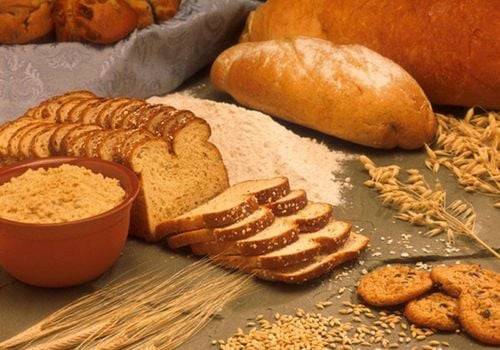This is an automatically translated article.
Introducing solid foods is one of the most exciting milestones in your baby's first year. There's a whole world of flavors to explore, and starting to eat solids is the first step. Encourage your baby to indulge himself when trying new foods, even if a good portion of them falls on the bib, tray, or floor.
1. When do babies start eating solids?
Most babies are ready to start solids by 4 to 6 months (and experts recommend waiting until close to 6 months in many cases), but your baby's personal development definitely stands. top of the list when deciding if it's time to introduce solids. While you may be more eager to start feedings early than late, there are plenty of reasons why it's not smart to start introducing solids too early.
First, getting used to solid foods can sometimes cause allergies. And the digestive system of young children from the tongue ejects any foreign matter placed on it, to the intestines still lacking many undeveloped digestive enzymes for solids. In addition, solid foods are not needed at an early age to meet all nutritional needs.
Giving your baby solid foods too soon can also affect future eating habits (he may refuse those spoons at first just because he's not ready, then may refuse because of the urge to eat). previous parental pressure). And especially in formula-fed babies, early introduction of solids can lead to obesity in the future.
On the other hand, waiting too long for example up to 9 months or later can also lead to potential pitfalls. Older children may not want to be taught new solids chewing and swallowing tricks, preferring to stick to tried and true bottle or breast feeding methods. Like habits, tastes can be difficult to change at this point. Unlike more pliable babies, an older baby may not like solids as milky liquids have long been a monopoly on the menu.
2. What are the signs my baby is ready for solid foods?
To decide if your baby is ready for the big step into the world of solid foods at 4 months, not until 6 months or any other time, refer to the following information and consult Consult your doctor:
Your baby can hold his head up well when in a sitting position. Even if your child is stressed, don't feed him until then. Weaning should wait until the baby can sit well on his own, usually no more than 7 months. The tongue thrust reflex is gone: use this test: Put a small amount of baby-friendly food diluted with breast milk or formula into your baby's mouth from the tip of a spoon or your finger. If the food comes right back to that little tongue and continues to do so after many tries, the thrust is still there and the baby is not ready for spoon feeding. Your baby shows interest in the food on the table. If your child takes the spoon out of your hand or watches and gets excited about every bite you take, it could be a sign that his appetite for food has grown.

Hầu hết trẻ sơ sinh đã sẵn sàng để bắt đầu ăn dặm từ 4 đến 6 tháng
3. Solid food for babies
No matter what's on the menu, the texture of your baby's first food should be super smooth and practically dripping on the spoon. If you're making your own food, strain, puree, or puree it, then dilute it with liquid if needed. As your baby becomes a more experienced eater (usually around 7 months of age or older), gradually reduce the liquid you add and thicken it more. Here are three foods to start with:
3.1. Cereals
If you're starting with baby cereal, choose a whole grain, rich in iron, like brown rice, whole oats or whole barley. To prepare, mix a small amount of baby cereal with formula, breast milk or even water to make a creamy "soup". Don't sweeten the taste by adding things like mashed bananas, apple sauce or juice first, as it's best to only offer one food at a time and second because it's better for babies born before you sweeten the cereal.
3.2. Vegetable
Start with lighter yellow or orange options like sweet potatoes and carrots before moving on to the green group, like peas and green beans, which have a slightly stronger flavor. If he refuses what you give him, try again tomorrow, the next day, and the next day. Some babies need to be introduced to a new food 10 to 15 times before they accept it, so persistence is key.

Hãy lựa chọn màu sắc thức ăn cho bé
3.3. Fruit
Delicious, easy-to-digest fruit first includes banana puree, apple sauce, peaches and pears. For something completely different and completely kid-friendly, start with a finely mashed or pureed ripe avocado that is creamy, delicious, and packed with healthy fats.
Skip pureed solids in favor of pliable solids presented in thick, long pieces that younger children can hold in their hands. However, the ability to grasp that helps babies transition to eating food with their hands, usually doesn't develop until about 8 months.
4. Monitor for allergic reactions
Although food allergies are relatively common in infants and some children outgrow them by age 5, they need to be taken seriously. Your child's reactions to food can range from gas, diarrhea, or mucus in the stool to vomiting and a rash especially around the mouth or bottom. Other symptoms include a runny nose, watery eyes, wheezing that doesn't seem to be caused by a cold, and waking or being unusually irritable, day or night.
If you think your baby may be allergic to something you gave him, wait about a week before trying the food again. If you get the same reaction two or three times in a row, you can assume she's sensitive to it. Eliminate that food from your child's diet for a few months, then try again if the pediatrician gives him the green light. If your baby seems to react to almost any new food you offer or there is a history of allergies in your family, wait a full week after trying any new food and check with your doctor.

Cần theo dõi các phản ứng của bé
5. When children choke, what should parents do?
Here's what to do to avoid choking on solid foods:
Keep a close eye on your baby's every bite. Cut foods into pieces small enough that your baby can swallow them whole if you don't give them time to chew (enthusiastic eaters often swallow them down). As your child gets used to eating soft, solid pieces of food (and as you get more comfortable watching her successfully eat them), gradually move up from mincing to chopping into small cubes. Only place one or two servings on a plate or tray at a time so she doesn't stuff in more than she can handle. Only feed your baby food when he is sitting down without crawling, or is a toddler. Eating while running is not safe for inexperienced eaters. Do not give your child foods that do not dissolve in the mouth, cannot be crushed by the gums, or can be easily absorbed into the windpipe. Avoid undercooked raisins, whole peas (unless they've been smashed), raw vegetables, firm meats (carrots, bell peppers) or fruit (apples, unripe pears, grapes), large chunks of meat, or Poultry and common choking hazards include popcorn, nuts, nut butters, and hot dogs.
For children to be healthy and develop well, it is necessary to have a nutritious diet in terms of quantity and quality balance. If children are not provided with adequate and balanced nutrients, it will lead to diseases of excess or lack of nutrients, which adversely affect the comprehensive development of children in terms of physical, mental and motor skills.
Children who do not eat properly are at risk of micro-mineral deficiency causing anorexia, growth retardation, malabsorption,... If they notice the above signs, parents should supplement their children with products. The supplement contains lysine, essential micro-minerals and vitamins such as zinc, chromium, selenium, and B vitamins to help fully meet the nutritional needs of children. At the same time, these essential vitamins also support digestion, enhance nutrient absorption, help improve anorexia, and help children eat well.
Parents can learn more:
Signs of zinc deficiency in children
Micronutrient deficiency and failure to gain weight in children
Please regularly visit Vinmec.com website and update useful information to take care of your child. Take care of the baby and the whole family.
REFERENCES: Nutrition.org.uk













